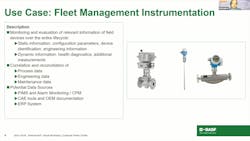At the recent Ethernet Advanced Physical Layer (APL) virtual workshop, experts from industrial networking organizations FieldComm Group, ODVA, OPC Foundation, and Profibus and Profinet International discussed the benefits of APL.
APL is a form of two-wire Single Pair Ethernet (SPE) which offers end users intrinsic safety for use in hazardous environments with a maximum cable length of 1,000 meters, full-duplex communication capabilities, and a bandwidth of up to 10 Mbit/second. Some of the most prominent benefits discussed at the virtual workshop include allowing process industry operators to pull more data from smart instruments installed in the field, as well as reducing the complexity of the commissioning process for new equipment.
One use case highlighted in the workshop involved chemical producer BASF. According to Kai Kruening, senior automation engineer at BASF, though his company’s facilities are often outfitted with dozens or even hundreds of Internet of Things (IoT) enabled smart instruments, it is seldom able to make use of the vast majority of the information collected due to the limited bandwidth of legacy fieldbus networks. As a result, only essential process variables are communicated over the network, leaving other types of data such as configuration parameters and health diagnostics stranded on the devices from which they originate.
BASF’s aim in deploying APL is to make the collection, evaluation, and correlation of many different types of data from diverse sources possible, with the goal of achieving three distinctive outcomes.
First, by pulling maintenance and engineering data from its devices in addition to process variables, BASF is constructing a digital twin of its operations environment. APL enables this by providing the necessary bandwidth and full-duplex or bi-directional communication functionality, which means that devices can receive control commands and transmit real-time data back to the digital twin simultaneously.
Secondly, by collecting diverse data from across its numerous sites, BASF can more effectively standardize its maintenance procedures, allowing a centralized facility to remotely oversee work done in disparate geographic locations.
Finally, the company hopes that by aggregating process, engineering, and maintenance data across the entire lifecycle of assets, it will be able to discover insights that can assist in further optimizing production. Once a large enough pool of time-series data is collected, correlations between equipment failures and other events can be identified either by human experts or via analysis by artificial intelligence (AI). As a result, predictive maintenance and other efficiencies can be achieved.
“We need much more bandwidth than we have today with our traditional fieldbus systems, and the reason for this is simple,” Kruening said. “We cannot do all these applications with fieldbus; but, more importantly, we cannot do them all at the same time. With APL, we can do everything at once, and finally bring digitalization into the field.”
About the Author
David Miller
Former Senior Technical Writer

Leaders relevant to this article:
